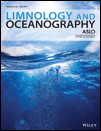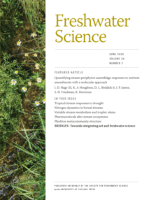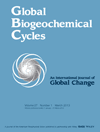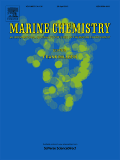
BIOGEOCHEMISTRY
Scope & Guideline
Exploring the vital connections between ecosystems and chemistry.
Introduction
Aims and Scopes
- Nutrient Cycling and Stoichiometry:
Research emphasizes the cycling of essential nutrients like carbon, nitrogen, and phosphorus in various ecosystems. Studies investigate stoichiometric relationships and their implications for ecosystem functioning. - Microbial Processes in Biogeochemistry:
The journal highlights the role of microorganisms in biogeochemical cycles, including their impact on nutrient transformations, greenhouse gas emissions, and organic matter decomposition. - Influence of Climate Change on Ecosystems:
A significant focus is on how climate change, including warming and altered precipitation patterns, affects biogeochemical processes and ecosystem health. - Aquatic and Terrestrial Interactions:
Research explores the connections between terrestrial and aquatic systems, particularly how land use and hydrology influence nutrient export and organic matter dynamics. - Restoration Ecology and Management Practices:
The journal includes studies on restoration practices and their effectiveness in mitigating environmental impacts, particularly in degraded ecosystems.
Trending and Emerging
- Impact of Climate Extremes:
There is an increasing focus on how extreme weather events, such as floods and droughts, affect biogeochemical processes. This includes examining the resilience of ecosystems under stress and the feedback mechanisms involved. - Microbial Ecology and Functional Traits:
Research is increasingly highlighting the functional traits of microbial communities and their roles in biogeochemical cycling, especially regarding nutrient retention and greenhouse gas emissions. - Integrative Approaches to Ecosystem Management:
Emerging trends show a preference for integrative and adaptive management strategies that consider ecological, social, and economic factors in biogeochemical research. - Innovative Analytical Techniques:
The use of advanced analytical techniques, such as molecular biology and isotopic tracing, is on the rise, allowing for more precise investigations into biogeochemical processes. - Urban and Anthropogenic Impacts:
There is a growing body of work addressing the biogeochemical impacts of urbanization and anthropogenic activities, particularly in relation to nutrient loading and water quality.
Declining or Waning
- Traditional Soil Chemistry Studies:
Research specifically centered on classical soil chemistry metrics seems to be waning, possibly as integrative approaches that consider biological and ecological interactions gain traction. - Focus on Static Models of Nutrient Cycling:
There is a noticeable decline in papers relying solely on static models of nutrient cycling, as more dynamic and complex modeling approaches are favored to account for variability and change. - Single Ecosystem Studies:
The trend is shifting away from studies focused exclusively on single ecosystems towards more integrative research that examines interactions across multiple ecosystems and scales.
Similar Journals

LIMNOLOGY AND OCEANOGRAPHY
Exploring the Depths of Aquatic ScienceLimnology and Oceanography is a premier peer-reviewed journal published by Wiley that has been at the forefront of aquatic sciences since its inception in 1956. With an impressive impact factor placing it in Q1 in both Aquatic Science and Oceanography categories, this journal showcases cutting-edge research and studies relevant to the dynamics of freshwater and marine ecosystems. Limnology and Oceanography serves as a vital platform for researchers, professionals, and students to disseminate their findings and foster a deeper understanding of aquatic environments. The journal does not currently offer open access, but it provides a unique opportunity for scholars to contribute to a body of work that influences policy, conservation efforts, and the scientific community at large. With its substantial ranking in Scopus as #12 in Aquatic Science and #9 in Oceanography, Limnology and Oceanography remains a critical resource for advancing knowledge in these vital fields.

MICROBIAL ECOLOGY
Delving into the vital roles of microorganisms in nature.MICROBIAL ECOLOGY, published by Springer, is a premier journal dedicated to advancing the field of microbial ecology, illuminating the intricate relationships between microorganisms and their environments. Established in 1974, the journal reflects a strong historical commitment to disseminating high-quality research, with its current scope encompassing groundbreaking studies that explore microbial dynamics in various ecosystems. In the 2023 rankings, it has secured a prestigious position in Q1 across multiple categories, including Ecology, Evolution, Behavior and Systematics, and Soil Science, indicating its influential contribution to scientific literature. While it does not offer Open Access, the journal remains highly accessible to researchers and professionals via institutional subscriptions. With an impressive Scopus ranking across significant ecological categories, it serves as an essential resource for academics looking to deepen their understanding of microbial interactions and ecological processes, thereby facilitating innovative research and practical applications in environmental science.

BOREAL ENVIRONMENT RESEARCH
Bridging Disciplines for a Sustainable Boreal FutureBOREAL ENVIRONMENT RESEARCH is a noteworthy academic journal published by the Finnish Environment Institute. Focusing on interdisciplinary studies within the realms of Agricultural and Biological Sciences, Atmospheric Science, Ecological Modeling, and Pollution, the journal aims to foster research that contributes to an improved understanding of boreal ecosystems and their interactions with global environmental changes. With an H-Index indicating a significant impact in the field and a convergence period extending from 1996 to 2024, BOREAL ENVIRONMENT RESEARCH serves as a platform for researchers, professionals, and students alike, promoting high-quality, peer-reviewed articles that address pressing environmental issues. Although it operates on a subscription basis, the journal's robust categorization within Q3 and Q4 quartiles highlights its relevance and commitment to facilitating academic dialogue and collaboration. Located in Helsinki, Finland, this journal stands as a vital resource for those dedicated to understanding and addressing the complex challenges faced by boreal environments.

Freshwater Science
Exploring the Depths of Freshwater EcologyFreshwater Science is a pivotal journal published by the University of Chicago Press, dedicated to advancing the understanding of freshwater ecosystems and their biodiversity. With an ISSN of 2161-9549 and an E-ISSN of 2161-9565, this journal has been a vital resource in the fields of Aquatic Science and Ecology, consistently ranked in the Q2 quartile across multiple categories in 2023. The journal encapsulates rigorous research and innovative studies aimed at addressing the ecological dynamics of freshwater environments from 2012 to 2024. Researchers and practitioners benefit from its open access options, which enhance the dissemination of knowledge while contributing to a better understanding of aquatic systems. With Scopus rankings that place it in the top 30% of its fields, Freshwater Science plays an influential role in fostering scientific dialogue and collaboration among professionals, making it an essential publication for anyone invested in freshwater conservation, management, and ecological impact.

Biogeosciences
Unveiling the secrets of our planet's biological and geological systems.Biogeosciences, published by COPERNICUS GESELLSCHAFT MBH in Germany, is a prestigious open access journal that has been a leading platform for innovative research since its establishment in 2004. With an impressive impact reflected in its Q1 rankings within both the Earth-Surface Processes and Ecology, Evolution, Behavior and Systematics categories, it caters to a diverse readership encompassing researchers, professionals, and students engaged in the life sciences and earth sciences. The journal's commitment to disseminating high-quality research is evident from its exemplary Scopus rankings, highlighting its role in fostering advancements and discussions in biogeoscience. With full open access options, readers worldwide can freely explore significant findings that contribute to our understanding of ecological and geoscientific principles. As the journal converges into its next decade, it continues to be an essential resource for those seeking to bridge the disciplines of biology and earth sciences.

GLOBAL BIOGEOCHEMICAL CYCLES
Bridging science and policy for environmental impact.GLOBAL BIOGEOCHEMICAL CYCLES, published by the American Geophysical Union, is a leading journal in the field of geochemistry that has gained significant recognition since its inception in 1987. With an impressive impact factor and a Q1 ranking in multiple categories such as Atmospheric Science, Environmental Chemistry, and Global and Planetary Change, it serves as a crucial platform for the dissemination of high-quality research. This journal emphasizes interdisciplinary studies focusing on biogeochemical processes and their implications for global environmental change, attracting contributions from a diverse range of scientific communities. Researchers, professionals, and students engaged in atmospheric sciences, environmental chemistry, and planetary sciences will find invaluable insights and state-of-the-art methodologies within its pages. GLOBAL BIOGEOCHEMICAL CYCLES continues to advance our understanding of the Earth’s systems, thus holding a pivotal position in shaping future environmental policies and sustainability efforts.

Geosciences is a prestigious open-access journal published by MDPI, dedicated to advancing research in the field of Earth and Planetary Sciences. Since its inception in 2011, this journal has fostered a collaborative environment for the dissemination of innovative ideas and findings, contributing significantly to the academic community's understanding of complex geological processes. The journal has achieved a commendable 2023 ranking in the second quartile (Q2) within its category, highlighting its impact and relevance in the field, with a Scopus rank of #41 out of 195 journals, placing it in the 79th percentile. With an aim to span a broad range of topics from environmental geology to planetary exploration, Geosciences is pivotal for researchers, professionals, and students looking for an accessible platform to share their work and stay informed of the latest developments. As a fully open-access journal, it ensures that high-quality research is freely available, fostering greater dissemination of knowledge across the globe.

MARINE CHEMISTRY
Innovating Solutions for Marine SustainabilityMARINE CHEMISTRY, published by Elsevier, is a premier international journal that has been at the forefront of advancing knowledge in the fields of chemistry, oceanography, and environmental science since its inception in 1972. As indicated by its impressive impact factor and its numerous Q1 rankings in Chemistry, Oceanography, and Water Science and Technology for 2023, the journal is a vital resource for researchers and professionals dedicated to addressing critical issues related to marine environments and their chemical dynamics. The journal publishes high-quality research that explores various aspects of chemical processes in aquatic systems, aiming to bridge the gap between theoretical studies and practical applications. With a significant emphasis on interdisciplinary work, MARINE CHEMISTRY serves as a platform for sharing innovative research findings that contribute to the sustainability and health of marine ecosystems. Although it is not an open-access publication, its comprehensive repository of scholarly articles remains accessible through institutional subscriptions, providing limitless opportunities for growth and discovery in the field.

Limnology and Oceanography Letters
Illuminating the depths of freshwater and marine science.Limnology and Oceanography Letters, published by WILEY, is an esteemed peer-reviewed journal dedicated to advancing our understanding of freshwater and marine systems. With an impressive Q1 ranking in both Aquatic Science and Oceanography, this journal has established itself as a pivotal resource for researchers, professionals, and students alike. Since its inception as an Open Access journal in 2016, it has provided unrestricted access to high-quality, innovative research articles that illuminate diverse aspects of aquatic ecosystems and their dynamics. With a publication history from 2016 to 2024 and a significant presence in Scopus rankings—placing it in the top 6% for Oceanography and the top 8% for Aquatic Science, this journal not only fosters scholarly communication but also encourages interdisciplinary collaboration. Addressing pressing issues related to water resource management, climate impact, and ecological integrity, Limnology and Oceanography Letters remains essential for those dedicated to the science of aquatic environments.

PEDOSPHERE
Bridging Disciplines to Enhance Soil UnderstandingPEDOSPHERE, published by SCIENCE PRESS, is a leading journal in the field of Soil Science, holding a prestigious position in the Q1 category as per the latest evaluations, reflecting its high impact and relevance in the domain. Established in 1996, this journal is committed to advancing our understanding of soil-related processes and their interactions with various environmental components, providing a platform for innovative and high-quality research. With an impressive rank of #13 out of 159 in the Scopus classifications for Agricultural and Biological Sciences, PEDOSPHERE reaches the 92nd percentile, indicating its significance among scholarly publications. Although the journal operates under traditional access options, it remains an essential resource for researchers, professionals, and students keen on exploring the complexities of soil dynamics and sustainability. By bridging interdisciplinary methodologies and fostering collaboration, PEDOSPHERE plays a vital role in addressing global challenges related to soil management, conservation, and ecological balance.